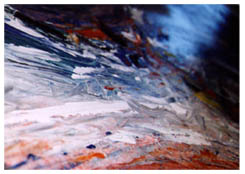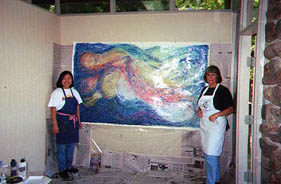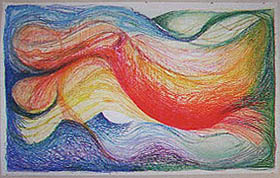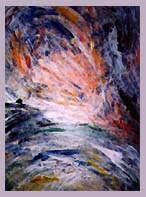
Inter-Connectedness, detail of Collaorative Painting
|
Collaboration with Shinobu Shinobu and I were about to embark on our collaborative journey. I hoped to share creative energy and explore possibilities for expression in a large space on paper with writng and art. I wanted to see ways I could more fully enjoy expression, ways I could simplify my work, my message and have fun too. Shinobu was Oriental, intruigingly aesthetic and open to life, spirit and wonder. |

|
The Classical guitar performance we attended before beginning our voyage moved me into a lovely flowing space of balanced energy, liveliness, acceptance and ready-for-anything-ness. It was perfect to be able to support this musician, purchase his CD and take his music with us on our adventure.
Shinobu writes:
Shinobu and I stopped by the art gallery on our way out. She had taken a few art classes in her 6 years studying at UALR, so knew a few of the artists in this all-faculty show. We took the time to look at the pieces, casually respond, and then re-visit the works we really liked. The monoprint by the new Art Department Chairman, Win Bruhl, snagged my attention: some recognizable images emerged, mostly expressive, somewhat abstract, but up front about the artist's process. Rather raw and visceral. Black and white, highly textural, deeply rooted in humanness and growth cycles. Shinobu went back again to the wax relief paintings, simplistic but expressive. We both liked the layering and odd shallow luminosity. This thesis project was validating many forlorn parts of my being as well as giving me blanket permission with my work. Juicing' my bones! |

|
As we headed toward the Wesley Foundation, the temporary painting studio where Shinobu and I would embark on our creative odyssey, we were met by the faculty-type artists whose work we had just viewed. Two art professors that we knew strolled together among the crowd moving down the hall. It appeared that an Art Dept. faculty meeting had just dispersed. Shinobu and I acknowledged the professors we knew and said how much we enjoyed the exhibit. Ignoring us completely, one of these professors turned to respond to the other professor as he asked her where her work was in the exhibit. She answered him as they continued on past us down the hall. Rather odd considering these two professors and I once shared a close friendship when I was compleing my undergraduate work in art several years before. Add to that, on the previous day, one of these professors and I had discussed paper and classroom space and the politics of making art in a thesis project without the Art Department's involvement. Ignoring our compliment just then seemed rather passive aggressive, if not downright rude. Was it my culture or my innate character makeup that gave me sensitivity to the situation? |

|
Shinobu never faltered. We trucked on out of the building and down the pine needle path to the Wesley Foundation, a friendly, well lit stone and wood abode just across from campus. Shinobu wanted to know all about my thesis project and how I thought we should approach our collaborative work together. I explained about expressive line drawings and writing down insights, and that writing could occur anywhere or at any time: on the work itself, on a separate work, in journals. I wanted to create a loose, free spirited approach to our work together. Given that Shinobu was Japanese, I wished to allow our communication to emerge, and the process of this project to be the focal point. The outcome, the product didn't matter. I was trusting the process of creative expression to show us the way, give us direction. But beginning this project with a friend, one whose culture, language and history were disparate, we were creating a safe place of detachment. I easily gained momentum. Somehow our values met in some accordant flow of joy in life, laughter and permission to explore together. Our work surface was a 4 foot by 7 foot sheet of heavy smooth milk carton paper. We were working on the stone tiled entry foyer of the Wesley Foundation. The foyer was a light colored panel, well lit, and just the right size for two people to work.
|

|
Shinobu writes:
We push pinned the paper on the wall, adjacent to the windows which lit the right side of the work. After spreading out materials that we both brought, we discussed a general plan of where we thought we wanted to head: crayon-pastels (cray-pas), pastels (colored chalks), maybe watercolor wash, possibly India ink at the end. Colors and lines, just design, no recognizable objects. Drawing and writing (?) on the work, to the side or on another surface (?) Not sure. Know we needed to just begin.
When the sense was there between us that we were ready, we exchanged glances and smiled. I picked up a fat red cray-pa and slung a long meandering line at a slight diagonal (upper left to lower right) across the paper. There were undulations and a squiggle. It broke the surface tension in two, in slightly unequal portions. We applied a rainbow of lines swirling on the surface. It didn't take long for us to work into our safe "comfort zone" of total reassurance of our collective direction, while we danced our colors all over the surface. This comfort zone involves an exchange between us: "ahhh yessss," "oh look," "that's great," "I like it," and most often "yeah yeah yeah yeah."
Shinobu writes: ha ha....that was fun. Yeah!
If one of us said "oh no, too much blue!" the other said "it's fine, it looks great, don't worry." One said, "I like that green area you're working on," or "I just want to get some yellow in here," then the other said "good, I'll add some yellow too."
Shinobu writes: This was interesting. I thought, "wow." TRUST.
We agreed many times that this was too much fun and that someone should send the fun police because having this much fun shouldn't be allowed.
Shinobu writes:
Total collaboration. Working as one loving person with four arms. How ideal is that? Each stroke and nuance we added, the other either complimented with a word or simple phrase, or complemented with color, line or texture. At first the swirls of color were very bright, childlike rainbow of lightness dancing on the surface. The lines swirled across the paper rather horizontally, moving in curving angles and twirling eddies. Right from that first session, we wanted to move the colors through dark in the lower left to white in the upper right crossing the angles of the swirling lines. It wasn't a discussion. It wasn't an analytical moment resolved. It was a miraculous intuitive knowing that gave Shinobu and me a congratulatory kick in the pants that we were on the right track. |

|
As Shinobu and I applied layer upon layer on our collaborative piece, each dancing back and forth, doh see doh-ing with color, line and synchronicity, I felt the connectiveness across the globe, across the centuries and into our human spirit.
Shinobu writes:
We whirled and swirled the energy around and in and through the paper and back out across the sky and under oceans. We melted barriers and united vision. We made peace in two hearts, a whole world of sanctity and humanness. Our courage and cleverness melted fear and darkness. We trusted with the open heart of a child. |

|
Which color now...where does this line go...what shall the next layer be like? We kept joining to work for no reason but to love breathing and bring this process out so we could taste it, walk away somewhat sated, and come back again another day for more. The layers progressed, transforming us, our visions, and our embodiment of the creative processes at hand. When the pastels ran out, we stroked with thick chunks of sidewalk chalk. A cloud of hazy softness gave way as we scraped the surface deep into the layers of color. We stood back. It needed more. Do we dare paint? Where do we...how...ohhhhh.... Ever so delicate baby swipes with brushes...oh yes yes yes. You take warm colors, I'll take cool. Oh wait, switch now. I just need to run my finger through this little bit. Oooo yeah. Oh wow. Yeah yeah yeah yeah. Oh my gosh. I can't keep my fingers out of the colors. Oh, more yellow now. Mmmmm. Here, put some blue here. Oh its so wonderful. Wow, look at your finger marks. Ha ha ha ha. Fingers dip into the color slipping across the crystallizing dream. Where are the fun police? This shouldn't be allowed. |

|
Will it ever find it's balance, unity and completion? Will the words be uttered: "That's it?" At times we knew we were drained of essential creative lifeworld energy (the teeter totter it took to practice the dance of line and color with one another). The energy just slipped out our fingers through the paint onto the work. We pushed from our hearts in clarity and regenerative light. The creative process took what was there and like a plant, pulled the lush life from the rooted tentacles to support the output until replenishment was required from the blanched remains.
| ||
|
Shinobu writes: |

|
I was also interested in the comments from people who had their classes in the Wesley Foundation where we were painting our piece. They saw the work's progress and they made comments. They saw the history of the work too.
Then we helped each other find a means of restful, resourceful closure on the session to balance the ecstasy play. Almost like the few lingering sparkles determined to fly free once the sparkler is spent. |

|
|
|
|
